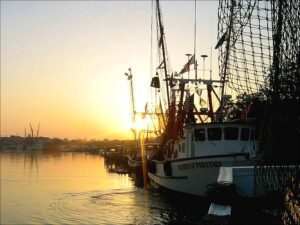Shrimp moratorium
A moratorium for the 2014 shrimp fishing season was announced for the US Northeastern Gulf of Maine shrimp fishery last week as stocks of shrimp for 2012 hit record lows. The last time the shrimp catch was halted was 35 years ago in 1977.
“The Northern Shrimp Technical Committee has considered the Gulf of Maine northern shrimp stock to have collapsed with very little hope for recovery in the near future,” Kelly Whitmore, chairwoman of the Atlantic States Marine Fisheries Commission told members of a section advisory panel on December 3rd, effectively halting all shrimping activities for the 2014 season, usually lasting from December through May. “There are no small shrimp around right now,” added Whitmore, “it doesn’t bode well for the future.”
 Declining shrimp stocks became strikingly apparent in 2012, with the annual survey last year showing the lowest number of adult shrimp ever recorded in the survey’s 30 year history. Despite pressure to halt the 2013 season, fishing went ahead with a reduced catch limit of 625 tons, or a 72 percent decrease from the allowable catch set for 2012. Even then, shrimpers only caught 307 tons for the 2013 season.
Declining shrimp stocks became strikingly apparent in 2012, with the annual survey last year showing the lowest number of adult shrimp ever recorded in the survey’s 30 year history. Despite pressure to halt the 2013 season, fishing went ahead with a reduced catch limit of 625 tons, or a 72 percent decrease from the allowable catch set for 2012. Even then, shrimpers only caught 307 tons for the 2013 season.
“I think everyone was startled by what we saw in 2012, and there was a lot of pressure to close down the fishery for the 2013 season,” said Chief Scientific Officer John Annala of the Gulf of Maine Research Institute. “The survey this summer found just 20 percent of the 2012 record low, so it has fallen off incredibly sharply.”
Of particular concern is the fact that no juvenile shrimp have shown up in any of of the surveys since 2010. Shrimp in the Gulf of Maine live for only about five years so the lack of any young shrimp for the past three years portends trouble for the future of the fishery for many years to come.
Overfishing, warming ocean waters
The sharp decline in shrimp in the region is largely attributed to overfishing and warming ocean waters.
“During the last ten years the water temperature in the Gulf of Maine has been running about 2.5 degrees Celsius or about 5 degrees Fahrenheit warmer than the previous one hundred year average,” Annala said. “We don’t know what the thermal threshold of this species is, but the Gulf of Maine has always been the southernmost extreme of their range, so we probably don’t have much wiggle room.”
Even if shrimp prove heat tolerant, which shouldn’t be assumed, the warming oceans of the Gulf of Maine are deadly to tiny zooplankton, the shrimp’s principal food supply. Warmer water also make the region more hospitable to predators of shrimp like dogfish and red hake.
Other species upon which the northeastern fisherman depend are also feeling the heat. The iconic lobster has been heading steadily northward in recent years in search of colder waters.
For the shrimp, the future remains tenuous. At this point, nobody is confident that 2014 will be the end of the moratorium.
“Decisions like this one show how fishermen are on the front lines of the battle against climate change,” said Michael Conathan, Director of Ocean Policy at the Center for American Progress. “This is not a nebulous, maybe-someday-in-the-future problem. This is unchecked carbon pollution affecting livelihoods here in Maine today.”
Image credit: Doug DuCap, courtesy flickr


